Polychrome
This article needs additional citations for verification. (August 2009) |
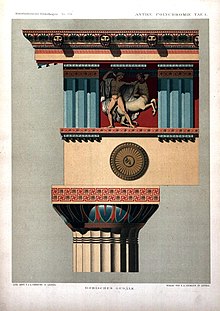
Polychrome is the "practice of decorating architectural elements, sculpture, etc., in a variety of colors."[1] The term is used to refer to certain styles of architecture, pottery, or sculpture in multiple colors.
When looking at artworks and architecture from antiquity and the European Middle Ages, people tend to believe that they were monochrome. In reality, the pre-Renaissance past was full of colour, and all the Greco-Roman sculptures and Gothic cathedrals, that are now white, beige, or grey, were initially painted in bright colours. As André Malraux stated: "Athens was never white but her statues, bereft of color, have conditioned the artistic sensibilities of Europe [...] the whole past has reached us colorless."[2] Polychrome was and is a practice not limited only to the Western world. Non-Western artworks, like Chinese temples, Oceanian Uli figures, or Maya ceramic vases, were also decorated with colours.
Ancient Near East
[edit]Similarly to the ancient art of other regions, Ancient Near Eastern art was polychrome, bright colours being often present. Many sculptures no longer have their original colouring today, but there are still examples that keep it. One of the best is the Ishtar Gate, the eighth gate to the inner city of Babylon (in the area of present-day Hillah, Babil Governorate, Iraq). It was constructed in c.575 BC by the order of King Nebuchadnezzar II on the north side of the city. It was part of a grand walled processional way leading into the city. Its colours are as rich as they were back in the day because the walls were made of glazed brick.
Many Ancient Near Eastern sculptures were painted too. Although they are grey today, all the Assyrian reliefs that decorated royal palaces were painted in highly saturated colours.
-
Assyrian tile with a guilloche border from the North-West Palace at Nimrud (now in modern Iraq), 883-859 BC, glazed earthenware, British Museum, London[3]
-
Reconstruction of a hall from an Assyrian palace, by Sir Austen Henry Layard, 1849
-
Assyrian panel with color projected on it, showing how it looked initially, in the Pergamon Museum. The color disappeared in many millennia and was damaged by the excessive cleaning of artifacts that took place in the 19th century
Ancient Egypt
[edit]Thanks to the dry climate of Egypt, the original colours of many ancient sculptures in round, reliefs, paintings, and various objects were well preserved. Some of the best preserved examples of ancient Egyptian architecture were the tombs, covered inside with sculpted reliefs painted in bright colours or just frescos. Egyptian artists primarily worked in black, red, yellow, brown, blue, and green pigments. These colours were derived from ground minerals, synthetic materials (Egyptian blue, Egyptian green, and frits used to make glass and ceramic glazes), and carbon-based blacks (soot and charcoal). Most of the minerals were available from local supplies, like iron-oxide pigments (red ochre, yellow ochre, and umber); white derived from the calcium carbonate found in Egypt's extensive limestone hills; and blue and green from azurite and malachite.
Besides their decorative effect, colours were also used for their symbolic associations. Colours on sculptures, coffins, and architecture had both aesthetic and symbolic qualities. Ancient Egyptians saw black as the colour of the fertile alluvial soil, and so associated it with fertility and regeneration. Black was also associated with the afterlife, and was the colour of funerary deities like Anubis. White was the colour of purity, while green and blue were associated with vegetation and rejuvenation. Because of this, Osiris was often shown with green skin, and the faces of coffins from the 26th Dynasty were often green. Red, orange, and yellow were associated with the sun. Red was also the colour of the deserts, and hence associated with Seth and the forces of destruction.[5][6]
Later, during the 19th century, expeditions took place that had the purpose of cataloging the art and culture of ancient Egypt. Description de l'Égypte is a series of early 19th century publications full of illustrations of monuments and artifacts of Ancient Egypt. Most are black-and-white, but some are colourful, so they can show the polychromy from the past. In some cases, only a few traces of paint remained on the walls, pillars and sculptures, but the illustrators attempted successfully at showing the buildings' original state in their pictures.[7]
-
Model paddling boat, c.1981-1975 BC, wood, paint, plaster, linen twine and linen fabric, Metropolitan Museum of Art, New York City
-
Colossal statue of Tutankhamun, c.1355-1315 BC, painted quartzite, Grand Egyptian Museum, Giza, Egypt
-
Composite papyrus capital, c.380–343 BC, polychrome sandstone, Metropolitan Museum of Art
-
Fragment of the sarcophagus of Djedthothiuefankh, 332-305 BC, wood and colourful glass, Museo Egizio, Turin, Italy
-
Statuette of Anubis, 332-30 BC, plastered and painted wood, Metropolitan Museum of Art
-
Winged sun on a cavetto at the Medinet Habu temple complex, Egypt, unknown architect, unknown date
-
Intact interior of the Ramesseum, Egypt, illustration from Description de l'Égypte, unknown illustrator, 1809
-
Egyptian patterns, motifs and capitals, unknown illustrator, published by L. Prang & Co., 1874
-
Egyptian motifs from L'Ornement Polychrome, by Albert Racinet, 1888
-
Various examples of Ancient Egyptian polychrome capitals, unknown illustrator, 19th century
-
Various examples of Ancient Egyptian corniches, unknown illustrator, 19th century
Classical world
[edit]
Some very early polychrome pottery has been excavated on Minoan Crete such as at the Bronze Age site of Phaistos.[9] In ancient Greece sculptures were painted in strong colors. The paint was frequently limited to parts depicting clothing, hair, and so on, with the skin left in the natural color of the stone. But it could cover sculptures in their totality. The painting of Greek sculpture should not merely be seen as an enhancement of their sculpted form but has the characteristics of a distinct style of art. For example, the pedimental sculptures from the Temple of Aphaia on Aegina have recently[when?] been demonstrated to have been painted with bold and elaborate patterns, depicting, amongst other details, patterned clothing. The polychrome of stone statues was paralleled by the use of materials to distinguish skin, clothing, and other details in chryselephantine sculptures, and by the use of metals to depict lips, nipples, etc., on high-quality bronzes like the Riace bronzes. The availability of modern digital methods and techniques have allowed the reconstruction and visualization of ancient 3D polychromy in a scientifically sound method and many projects have explored these possibilities in the last years. [10]
An early example of polychrome decoration was found in the Parthenon atop the Acropolis of Athens. By the time European antiquarianism took off in the 18th century, however, the paint that had been on classical buildings had completely weathered off. Thus, the antiquarians' and architects' first impressions of these ruins were that classical beauty was expressed only through shape and composition, lacking in robust colors, and it was that impression which informed neoclassical architecture. However, some classicists such as Jacques Ignace Hittorff noticed traces of paint on classical architecture and this slowly came to be accepted. Such acceptance was later accelerated by observation of minute color traces by microscopic and other means, enabling less tentative reconstructions than Hittorff and his contemporaries had been able to produce. An example of classical Greek architectural polychrome may be seen in the full size replica of the Parthenon exhibited in Nashville, Tennessee, US.
-
Traces of paint depicting embroidered patterns on the peplos of an Archaic Kore, c.530 BC marble, Acropolis Museum, Athens, Greece
-
Polychrome on the Peplos Kore, c.530 BC, Parian marble, Acropolis Museum
-
Peplos Kore color reconstruction
-
Reconstructed color scheme on a Trojan archer from the Temple of Aphaia, Aegina
-
Amathus Sarcophagus, c.475-450 BC, limestone, Metropolitan Museum of Art, New York City
-
Hades and Persephone, c.340 BC, pigments on marble, Museum of the Royal Tombs of Aigai, Vergina, Greece[12]
-
Facade of an ancient tomb at Agios Athanasios, c.325–300 BC, Macedonia, Greece
-
Terracota figurine of a woman with painted blue and gilt garment, from Tanagra, 325–300 BC, Antikensammlung Berlin, Germany
-
Terracota figurine of a young woman, with kaolin and traces of polychromy, 3rd-2nd century BC, Liebieghaus, Germany[14]
-
Roman mosaic of Neptune and Amphitrite, c.70 BC, mosaic, Casa di Nettuno e Anfitrite, Herculaneum Archaeological Park, Ercolano, Italy[15]
-
Roman shield, mid 3rd century, painted wood and hide, Yale University Art Gallery, New Haven, USA[16]
-
Reconstruction of the Temple of Empedocles at Selinunte, Sicily, by Jacques Ignace Hittorff, 1830 (published in 1851)[17]
-
Traces of red paint in Korai busts from the Hellenistic period, Museo Archeologico Paolo Orsi, Syracuse, Sicily
-
Reconstructed elevation of the main facade of the Temple T at Selinunte, Sicily, by Jacques Ignace Hittorff, before 1859
East Asia
[edit]Chinese art is known for the use of vibrant colours. Neolithic Chinese ceramic vessels, like those produced by the Yangshao culture, show the use of black and red pigments. Later, tomb and religious sculptures appear as a consequence of the spread of Buddhism. The deities most common in Chinese Buddhist sculpture are forms of the Buddha and the bodhisattva Guanyin. Traces of gold and bright colours in which sculptures were painted still give an idea of their effect. During the Han and Tang dynasties, polychrome ceramic figurines of servants, entertainers, tenants, and soldiers were placed in the tombs of people from upper-class. These figurines were mass-produced in moulds. Although Chinese porcelain is best known as being blue-and-white, many colorful ceramic vases and figures were produced during the Ming and Qing dynasties. During the same two dynasties, cloisonné vessels that use copper wires (cloisons) and bright enamel were also manufactured.
Similarly to what was happening in China, the introduction of Buddhism in Japan in 538 (or perhaps 552 AD) lead to the production of polychrome Japanese Buddhist sculptures. Japanese religious imagery had until then consisted of disposable clay figures used to convey prayers to the spirit world.[18]
-
Tang dynasty mural of architecture from Mogao Grottoes.
-
Guanyin of the southern seas (Chinese), 11th-12th centuries, painted and gilded wood, Nelson-Atkins Museum of Art, Kansas City, USA[19]
-
Scholar oficial (Chinese), 618-907 AD, painted and glazed ceramic, Shaanxi History Museum, Xi'an, China[20]
-
The Guanyian Pavilion of the Dule Monastery, Jixian, China, unknown architect, 984
-
Ming dynasty caihua decorations on Hall of Amitābha at Longxing Temple.
-
Hall of Prayer for Good Harvests, the main building of the Temple of Heaven, Beijing, unknown architect, 1703–1790
-
Song dynasty "Wucai Caihua" (Five Coloured Painting)-dougong decorations guide as detailed on the Yingzao Fashi
-
Chinese motifs from L'Ornement Polychrome, by Albert Racinet, 1888
-
Chinese and Japanese cloisonné motifs from L'Ornement Polychrome
-
Japanese cloisonné motifs from L'Ornement Polychrome
Medieval
[edit]Throughout medieval Europe religious sculptures in wood and other media were often brightly painted or colored, as were the interiors of church buildings. These were often destroyed or whitewashed during iconoclast phases of the Protestant Reformation or in other unrest such as the French Revolution, though some have survived in museums such as the V&A, Musée de Cluny, and Louvre. The exteriors of churches were painted as well, but little has survived. Exposure to the elements and changing tastes and religious approval over time acted against their preservation. The "Majesty Portal" of the Collegiate church of Toro is the most extensive remaining example, due to the construction of a chapel which enclosed and protected it from the elements just a century after it was completed.[22]
-
Romanesque - Last Judgement tympanum, Abbey Church of Sainte-Foy, Conques, France, early 12th century[23]
-
Romanesque - Madonna and Child Entroned, 12th century, walnut, silver, silvered copper and polychrome, Basilique Notre-Dame d'Orcival, Orcival, France[24]
-
Gothic - Ekkehard and Uta, attributed to the Master of Namburg, 1245–1260, limestone and polychromy, Naumburg Cathedral, Naumburg, Germany[26]
-
Gothic - Reliquary altarpiece with Saint Ursula, c.1325, gilded and painted wood, Abteikirche Marienstatt, Streithausen, Germany[27]
-
Gothic - Portal at the Collegiate Church of Toro
-
Gothic - Bust of the Virgin, c.1390-1395, terracotta with paint, Metropolitan Museum of Art, New York City
-
Gothic - Irene, daughter of Cratin, painting a sculpture of the Virgin Mary, France, 1401-1402. Detail from Giovanni Bocaccio's De Claris mulieribus (Concerning famous women), 1403 edition, Bibliothèque nationale de France, Paris
-
Gothic - Enthroned Virgin, c. 1490-1500, limewood with gesso, paint and gilding, Metropolitan Museum of Art
-
Portal of the Burgos Cathedral, Burgos, Spain, unknown architect, unknown date
17th and 18th centuries
[edit]
While stone and metal sculpture normally remained uncolored, like the classical survivals, polychromed wood sculptures were produced by Spanish artists: Juan Martínez Montañés, Gregorio Fernández (17th century); German: Ignaz Günther, Philipp Jakob Straub (18th century); or Brazilian: Aleijadinho (19th century).
Monochromatic color solutions of architectural orders were also designed in the late, dynamic Baroque, drawing on the ideas of Borromini and Guarini. Single-colored stone cladding was used: light sandstone, as in the case of the façade of the Bamberg Jesuit church (Gunzelmann 2016) designed by Georg and Leonhard Dientzenhofer (1686–1693), the façade of the monastery church in Michelsberg by Leonard Dientzenhofer (1696), and the abbey church in Neresheim by J.B. Neumann (1747–1792).[31]
In the space of present-day Germany, during the 18th century, the Asam brothers (Egid Quirin Asam and Cosmas Damian Asam) designed churches with undulating walls, curved borken pediments and polychromy.[32] In the German-speaking space, multiple Rococo churches and libraries with pastel polychrome stuccos and columns were built. There, faux marble columns are made from wood pillars that are covered in a layer of polychrome stucco, a mixture of plaster, lime, and pigment. When these ingredients are mixed, a homogenous-coloured paste is created. To achieve the marble look, thinner batches of darker and lighter paste are made, so that veins begin to appear. It’s all roughly mixed by hand. When the material hardens it's polished by rubbing with fine sandpaper, and thus this layer of polychrome stucco becomes glossy and imitates really realistically marble. A good example of this is the Library of the Wiblingen Abbey in Ulm, Germany. Faux marble made of stucco will continue to be used during the 19th and early 20th centuries too. It is used only for interiors, because stucco dissolves outside through of contact with water.
In Wallachia, during the late 17th and early 18th centuries, the Brâncovenesc style was popular in architecture and decorative arts. It is named after Prince Constantin Brâncoveanu, during whose reign it was developed. Some of the churches in this style have polychrome facades, decorated with murals, like the church of the Stavropoleos Monastery in Bucharest, Romania.
The 2nd half of the 18th century was the rise of Neoclassicism, a movement which tries its best at reviving the styles of Ancient Greece, Rome, the Etruscan civilization, and sometimes even Egypt. During Louis XVI's reign (1760-1789), interiors in the Louis XVI style start to be decorated with arabesques, inspired by those discovered in ancient houses in Pompeii and Herculaneum. They are painted in pastel colours, painted white with the ornate parts gilt, or polychrome. The State Dining Room of the Inveraray Castle in Scotland, decorated by two French painters, is a good example of a polychrome Louis XVI style interior.
-
Baroque - Escalier des Ambassadeurs of the Palace of Versailles, Versailles, France, by François d'Orbay and Charles Le Brun, 1674-1679, demolished in 1752 under Louis XV[33]
-
Baroque - Hall of Mirrors of the Palace of Versailles, by Jules Hardouin-Mansart, 1678-1684[34]
-
Baroque - Church of San Francisco Acatepec, San Andrés Cholula, Mexico, unknown artchitect, 17th–18th centuries
-
Baroque - The Entombment of Christ, by Luisa Roldán, 1700-1701, polychrome terracotta, Metropolitan Museum of Art, New York City
-
Rococo - Interior of the Klosterbibliothek Metten, Metten, Germany, unknown architect, 1722-1726[35]
-
Rococo - Capitals in the Wallfahrtskirche Steinhausen, Steinhausen, Germany, by Dominikus Zimmermann, 1728-1733
-
Baroque - Summer as Ceres, part of a series of anthropomorphic busts of the four seasons, a polychrome example of Rouen faience, c.1730, faience, Louvre[37]
-
Rococo - Helbling House, Innsbruck, Austria, originally Gothic town house from the 15th century, renovated at the beginning of the 18th, and finished in 1732 by Anton Gigl
-
Rococo - St. Johann Nepomuk, Munich, Germany, by Egid Quirin Asam and Cosmas Damian Asam, 1733-1746[38]
-
Rococo - Apartment of Madame du Barry, Palace of Versailles, Versailles, France, by Ange-Jacques Gabriel, 18th century
-
Rococo - Illustration of 18th century cartouches, from L'ornement Polychrome, by Albert Racinet, 1888
-
Rococo - fourth guest room, so-called Voltaire Room, Sanssouci, Potsdam, Germany, designed by Georg Wenzeslaus von Knobelsdorff, with decoration by Johann Michael the Elder and Johann Christian Hoppenhaupt the Younger, 1752-1753[39]
-
Rococo - Pilgrimage Church of Wies, Steingaden, Germany, by Dominikus and Johann Baptist Zimmermann, 1754[40]
-
Rococo - Tobias and the Angel, by Ignaz Günther, 1763, limewood, Bürgersaalkirche, Munich, Germany[41]
-
Chinoiserie - Chinese Pavilion (Ekerö Municipality, Sweden), 1763–1769, by Carl Fredrik Adelcrantz[42]
-
Neoclassical - armchair, c.1780, carved and polychromed walnut, received upholstered in beige silk brocade, currently upholstered with modern cotton and linen velvet, Metropolitan Museum of Art
-
Louis XVI style - Ceiling decorated with festoons in the State Dining Room, Inveraray Castle, Scotland, the UK, by Girard and Guinand, 1784[43]
Porcelain
[edit]With the arrival of European porcelain in the 18th century, brightly colored pottery figurines with a wide range of colors became very popular. Porcelain was developed in China in the 9th century. Its recipe was kept secret from other nations, and only successfully copied in the 15th century by the Japanese and Vietnamese. During the 18th century, German kilns finally figured out how to make porcelain, beginning with the alchemist Johann Friedrich Böttger and the physicist Ehrenfried Walther von Tschirnhaus, who made the first European variety in 1709. The Meissen Porcelain Factory was founded in the following year, and it became the leading European porcelain manufacturer. Later, other kilns stole the recipe or came up with their own porcelain technology. Another really famous factory was the Sèvres, which produced stunning porcelain for the French elite during the 18th, 19th and 20th centuries.[44]
-
Rococo - elephant-head vase (vase à tête d'éléphant), by the Sèvres porcelain factory, c.1756-1762, soft-paste porcelain, Metropolitan Museum of Art
-
Rococo - wall sconce (bras de cheminée), by the Sèvres porcelain factory, c.1761, soft-paste porcelain and gilt bronze, Metropolitan Museum of Art
-
Rococo - perfume vase, by the Chelsea porcelain factory, c.1761, soft-paste porcelain and burnished gold ground, Metropolitan Museum of Art
-
Rococo - singerie figurine, part of a monkey band, by the Meissen porcelain factory, c.1765, porcelain, enamel and gilding, Art Institute of Chicago, Chicago, USA
-
Rococo - The Music Lesson, by the Chelsea porcelain factory, c.1765, soft-paste porcelain, Metropolitan Museum of Art
-
Louis XVI style - Vase (vase grec Duplessis rectifié), design attributed to Jean-Claude Chambellan Duplessis, painted decoration by Vincent Taillandier, gilding by Jean Pierre Boulanger, by the Sèvres porcelain factory, 1780, painted and gilded hard-paste porcelain, gilt bronze, Rijksmuseum Amsterdam, the Netherlands
19th century
[edit]Compared to the 18th century, polychromy was somewhat more widespread in the 19th. However, the facades of most buildings remained white, most sculptures were unpainted, and most furniture was in the shades of its materials. Colours were added usually though glazed ceramics on buildings, different types of stone on sculptures, and through painting or intarsia most often on furniture. Like in the 18th century, porcelain remained quite colourful, many figures being life-like. In contrast with their exteriors, interiors of many houses of the rich were often decorated with boiserie, stucco, and/or painted. Like in the 2nd half of the 18th century, multiple bronze clocks and decorative objects have two tints through gilding and patina. Porcelain elements were also added for more colour.
-
Gothic Revival clock, c.1835-1850, gilt and patinated bronze, Museum of Decorative Arts, Paris
-
Gothic Revival - Interior of the St Giles' Catholic Church, Cheadle, Staffordshire, the UK, by Augustus Pugin, 1840-1846[45]
-
Gothic Revival - Chimney-piece in the Chaucer Room of the Cardiff Castle, Cardiff, the UK, by William Burges, c.1877-1890[46]
-
Beaux Arts - Ceiling stucco fragment from Strada Plantelor no. 4, Bucharest, Romania, unknown architect, 1891
-
Art Nouveau - Nature Unveiling Herself Before Science, by Louis-Ernest Barrias, 1899, marble, alabaster, calcite, malachite, lapis lazuli, Musée d'Orsay, Paris
Neoclassicism
[edit]Despite evidence of polychrome being discovered on Ancient Greek architecture and sculptures, most Neoclassical buildings have white or beige facades, and black metalwork. Around 1840, the French architect Jacques Ignace Hittorff, published studies of Sicilian architecture, documenting extensive evidence of color. The "polychrome controversy" raged for over a decade and proved to be a challenge for Neoclassical architects throughout Europe.[17]
Due to the discovery of frescos in the Roman cities Pompeii and Herculaneum during the 18th century, multiple 18th and 19th century Neoclassical houses have their interiors decorated with colourful Pompeian style frescos. They often feature bright red, known as "Pompeian red". The fashion for Pompeian styles of painting resulted in rooms finished in vivid blocks of colour. Examples include the Pompeian Room from the Hinxton Hall in Cambridgeshire, the Pompejanum in Aschaffenburg, Empress Joséphine's Bedroom from the Château de Malmaison, and Napoleon's bath of the Château de Rambouillet. By the beginning of the 19th century, painters were also able to create effects of marbling and graining to imitate wood.
-
Empire style - Napoleon's bath of the Château de Rambouillet, Rambouillet, France, painted by Godard and Jean Vasserot, 1806
-
Empire style - Vase, by the Sèvres porcelain factory, 1814, hard-paste porcelain with platinum background and gilt bronze mounts, Louvre[48]
-
Neoclassical - Polychromatic façade of the Cirque Nationale, Paris, by Jakob Ignaz Hittorff, 1840[49]
-
Neoclassical - Putto of the Grande Fontaine (Avenue Léopold-Robert), La Chaux-de-Fonds, Switzerland, by Maximilien Louis Bourgeois, 1888
-
Neoclassical - Pompeian style wall in Strada Nicolae Filipescu no. 45, Bucharest, Romania, unknown architect or painter, c.1890
-
Coffered ceiling with polychromy in front of the main entrance of the Academy of Athens, completed in 1885.
19th century maximalism
[edit]"More is more" was the aesthetic principle followed in the Victorian era. Maximalism is present in many types of Victorian era designs, like ceramics, furniture, cutlery, tableware, fashion, architecture, book illustration, clocks, etc. Despite the appetite for ornamentation, many of them remain decorated with only a few colours, especially furniture. Ceramics were the field where polychrome was widespread. Besides objects, polychrome ceramic was also present in architecture and some furniture pieces and architecture through tiles.
The objects and buildings of the 19th century shown in the galleries of this page are without any doubt impressive. Today were are delighted by their ornaments, colours, and styles. However, up to the 1960s, with the rise of Postmodernism, when people started to question Modernism and began to appreciate things from the pre-Modern past, the verdict of Victorian designs wasn't good. During the early 20th century and even when they were made, some described the Victorian age as being one that has been providing us with some of the ugliest objects that have ever been made. Descriptions like 'aesthetic monstrosities' or 'ornamental abominations' were around at the time, and it only got worse. At the end of the 19th century, Marc-Louis Solon (1835-1913), a well established ceramic designer, who worked for Minton and Company, was not unusual in commenting that the period 'bears the stamp of an unmitigated bad taste'.[50] As time passed, negative opinions only got worse. Pioneer Mondern architects Adolf Loos and Le Corbusier felt that works like this were not simply bad, they were such an affront they should have been made illegal.[51]
-
Rococo Revival incense burner (brûle-parfum), by Jacob Petit, c.1834-1848, hard-paste porcelain, painted and gilded, Museum of Decorative Arts, Paris
-
Rococo Revival pair of bottles, by Jacob Petit, c.1840, hard-paste porcelain, painted and gilded, Museum of Decorative Arts, Paris
-
Rococo Revival pair of cone-shaped vases and a clock, by Nicolas Bugeard?, mid-19th century, hard-paste porcelain, painted and gilded, Museum of Decorative Arts, Paris
-
Neoclassical sculpted decoration on the ceiling of the Salon des Sept cheminées, Louvre Palace, Paris, by Francisque Duret, 1851[52]
-
Neoclassical sculpted decoration on the ceiling of the Salon Carré, Louvre Palace, by Pierre-Charles Simart, 1851[53]
-
Polychrome architectural detail of an unidentified building in Kendallville, Indiana, USA, unknown architect, 1892
-
Interior of La Cigale, Nantes, France, designed by Émile Libaudière, and decorated with sculptures by Émile Gaucher and paintings by Georges Levreau, 1895
Polychrome brickwork
[edit]Polychrome brickwork is a style of architectural brickwork which emerged in the 1860s and used bricks of different colours (brown, cream, yellow, red, blue, and black) in patterned combinations to highlight architectural features. These patterns were made around window arches or were just applied on walls. It was often used to replicate the effect of quoining. Early examples featured banding, with later examples exhibiting complex diagonal, criss-cross, and step patterns, in some cases even writing using bricks.[54] Elements of glazed ceramic with details were also used for more complex ornaments.
-
Detail of the Pernot Biscuit Factory (Rue Courtepée no. 10-18), Dijon, France, 1879
-
Facade of the (now) Suriname Embassy (Rue du Ranelagh no. 94), Paris, unknown architect, 1885
Romanian Revival style
[edit]In the Kingdom of Romania, the Romanian Revival style appeared at the end of the 19th century. It is the Romanian equivalent of the National Romantic style that was popular at the same time in Northern Europe. The movement is heavily inspired by Brâncovenesc architecture, a style that was popular in Wallachia in the late 17th and early 18th centuries. Interiors of houses in this style built before WW1 are often decorated with a variety of bright colours. In the case of a few buildings, the polychrome extends on the exterior too, through the use of colorful glazed ceramic tiles. The style became more popular in the 20th century. A Romanian Revival house that stands out through its variety of colours is the Gheorghe Petrașcu House (Piața Romană no. 5) in Bucharest, by Spiru Cegăneanu, 1912[58]
-
Gheorghe Ionescu-Gion House (Strada Logofătul Udriște no. 11), Bucharest, Romania, by Ion N. Socolescu, 1889[59]
-
Ceiling of the Gheorghe Petrașcu House (Piața Romană no. 5), Bucharest, by Spiru Cegăneanu, 1912[61]
-
Ceiling of the Gheorghe Petrașcu House, Bucharest, by Spiru Cegăneanu, 1912[62]
20th century
[edit]In the twentieth century there were notable periods of polychromy in architecture, from the expressions of Art Nouveau throughout Europe, to the international flourishing of Art Deco or Art Moderne, to the development of postmodernism in the latter decades of the century. During these periods, brickwork, stone, tile, stucco, and metal facades were designed with a focus on the use of new colors and patterns, while architects often looked for inspiration to historical examples ranging from Islamic tilework to English Victorian brick.
Before World War I
[edit]At the beginning of the 20th century, before the world wars, Revivalism (including Neoclassicism and the Gothic Revival) and eclecticism of historic styles were very popular in design and architecture. Many of the things said about the 19th century are still in this period. Many of the buildings from this period have their interiors decorated with colours, through tiles, mosaics, stuccos, or murals. When it comes to exteriors, most polychrome facades are decorated with ceramic tiles.
Art Nouveau was also in fashion during the 1900s all over the Western world. However, it fragmented by 1911 and from then it steadily faded, until it disappeared with WW1. Some regular Art Nouveau buildings have their facades decorated with colourful glazed ceramic ornaments. The colours used are often more earthy and faded compared to the intense ones used by Neoclassicism. Compared to other movements in design and architecture, Art Nouveau was one with different versions in multiple countries. The Belgian and French form is characterized by organic shapes, ornaments taken from the plant world, sinuous lines, asymmetry (especially when it comes to objects design), the whiplash motif, the femme fatale, and other elements of nature. In Austria, Germany and the UK, it took a more stylized geometric form, as a form of protest towards revivalism and eclecticism. The geometric ornaments found in Gustav Klimt's paintings and in the furniture of Koloman Moser are representative of the Vienna Secession (Austrian Art Nouveau). In some countries, artists found inspiration in national tradition and folklore. In the UK for example, multiple silversmiths used interlaces taken from Celtic art. Similarly, Hungarian, Russian, and Ukrainian architects used polychromatic folkloric motifs on their buildings, usually through colourful ceramic ornaments.
-
French Art Nouveau - Vase, by Clément Massier, c.1900, lusterware, Jason Jacques Gallery, New York[65]
-
French Art Nouveau - Avenue Gallieni no. 14, Paris, by Eugène Coulon, 1903–1904
-
French Art Nouveau - Entrance decorated with glazed tiles of the Les Chardons Building (Rue Eugène-Manuel no. 2), Paris, 1903, by Charles Klein[67]
-
Ukrainian Art Nouveau - Poltava Reginal Administrative Building, Poltava, Ukraine, by Vasyl Krychevsky, 1903–1907[68]
-
Austrian Art Nouveau - Putto with two cornucopias with floral cascades, by Michael Powolny, designed in c.1907, produced in 1912, ceramic, Kunstgewerbemuseum Berlin, Berlin, Germany[69]
-
Russian Revival - Window of the Church of the Theotokos of Tikhvin, Moscow, by Nikolay Martyanov, 1911-1912
-
Moorish Revival - Ceiling in the Filitti House (Calea Dorobanților no. 18), Bucharest, by Ernest Doneaus, c.1910[70]
-
Beaux Arts - Stucco with putti on a ceiling in Piața Romană no. 3, Bucharest, by Siegfired Kofsinski and C. Crețoiu, 1912
Modernism
[edit]During the interwar period and the middle of the 20th century, Modernism was in fashion. To Modernists, form was more important than ornament, so solid blocks of strong colour were often used to emphasize shape and create contrast. Primary colours and black and white were preferred. This is really the case of the Dutch De Stijl movement, which began in 1917. The style involved reducing an object (whether a painting or a design) to its essentials, using only black, white and primary colours, and a simple geometry of straight lines and planes. Gerrit Rietveld's Red and Blue Chair (1917-1918) and Rietveld Schröder House in Utrecht (1924) show this use of colour. Polychromy in Modernist design was not limited to De Stijl. The Unité d'habitation, a residential housing typology developed by Le Corbusier, has some flat colourful parts.
Some Art Deco objects, buildings and interiors stand out through their polychromy and use of intense colours. Fauvism, with its highly saturated colours, like the paintings of Henri Matisse, was an influence for some Art Deco designers. Another influence for polychromy were the Ballets Russes. Leon Bakst's stage designs filled Parisian artistic circles with enthusiasm for bright colours.[71]
Despite their lack of ornamentation, multiple Mid-century modern designs, like Lucienne Day's textiles, Charles and Ray Eames's Hang-It-All coat hanger (1953), or Irving Harper's Marshmallow sofa (1956), are decorated with colours. Aside from individual objects, mid-century modern interiors were also quite colourful. This was also caused by the fact that after WW2, plastics became increasingly popular as a material for kitchenware and kitchen units, light fixtures, electrical appliances and toys, and by the fact that plastic could be produced in a wide range of colours, from jade green to red.[72]
-
De Stijl - Red and Blue Chair, by Gerrit Rietveld, 1917, lacquered wood, Toledo Museum of Art, Toledo, Ohio, USA
-
De Stijl - Panel of polychrome bricks on the exterior of the Vakantiehuis De Vonk, a house in Noordwijkerhout, the Netherlands, by Theo van Doesburg, 1917-1919[73]
-
Mix of Pueblo Revival and Art Deco (Pueblo Deco): KiMo Theater, Albuquerque, US, by the Boller Brothers, 1927
-
Art Deco - Floor in the entrance hall of Bulevardul Hristo Botev no. 26, Bucharest, unknown architect, 1930s
-
Art Deco - Marble facing in the entrance hall of Strada Pitar Moș no. 27–29, Bucharest, by Sandy Herivan, 1931-1933[75]
-
Art Deco - Mosaics on the facade of Quai Louis-Blériot no. 40, Paris, by Marteroy & Bonnel, 1932[76]
-
Mid-century modern - Marshmallow sofa, by Irving Harper for George Nelson Associates, 1956, metal frame with round discs of covered foam, unknown location[78]
Postmodernism
[edit]The use of vivid colours continued with Postmodernism, in the 1970s, 1980s and 1990s. Compared to Mid-century modern objects, which often had intense colours but were monochrome, Postmodern design and architecture stand out through the use of a variety of colours on single objects or buildings. Postmodern architects working with bold colors included Robert Venturi (Allen Memorial Art Museum addition; Best Company Warehouse), Michael Graves (Snyderman House; Humana Building), and James Stirling (Neue Staatsgalerie; Arthur M. Sackler Museum), among others. In the UK, John Outram created numerous bright and colourful buildings throughout the 1980s and 90s, including the "Temple of Storms" pumping station. Aside from architecture, bright colours were present on everything, from furniture to textiles and posters. Neon greens and yellows were popular in product design, as were fluorescent tones of scarlet, pink, and orange used together. Injection-moulded plastics gave designers new creative freedom, making it possible to mass produce almost any shape (and colour) quickly and cheaply.[81]
An artist well known for her polychrome artworks is Niki de Saint Phalle, who produced many sculptures painted in bold colours. She devoted the later decades of her life to building a live-in sculpture park in Tuscany, the Tarot Garden, with artworks covered in vibrant colourful mosaics.[82]
-
Proust armchair, by Studio Alchimia, 1978, wood and fabric, Indianapolis Museum of Art, Indianapolis, USA[83]
-
Sheraton chair with applied decoration, by Robert Venturi for Knoll, 1978-1984, bent laminated wood, Milwaukee Art Museum, Milwaukee, USA[84]
-
Plaza dressing table and stool, by Michael Graves for the Memphis Group, 1981, painted wood, natural rosehips, mirrors, and bulbs, Museum of Decorative Arts, Paris
-
Carlton Bookcase, by Ettore Sottsass for the Memphis Group, 1981, wood veneer and plastic laminate, Museum of Decorative Arts, Paris
-
Super Lamp, by Martine Bedin for the Memphis Group, 1981, glazed stoneware, rubber and chrome-plated steel, Museum of Decorative Arts, Berlin, Germany
-
Louis XVI, lowboy, by Robert Venturi for Arc International, c.1985, laminated wood, Indianapolis Museum of Art[86]
-
L'Ange Protecteur, by Niki de Saint Phalle, 1997, unknown materials, Zürich Hauptbahnhof, Zürich, Switzerland
United States
[edit]Polychrome building facades later rose in popularity as a way of highlighting certain trim features in Victorian and Queen Anne architecture in the United States. The rise of the modern paint industry following the American Civil War also helped to fuel the (sometimes extravagant) use of multiple colors.


The polychrome facade style faded with the rise of the 20th century's revival movements, which stressed classical colors applied in restrained fashion and, more importantly, with the birth of modernism, which advocated clean, unornamented facades rendered in white stucco or paint. Polychromy reappeared with the flourishing of the preservation movement and its embrace of (what had previously been seen as) the excesses of the Victorian era and in San Francisco, California in the 1970s to describe its abundant late-nineteenth-century houses. These earned the endearment 'Painted Ladies', a term that in modern times is considered kitsch when it is applied to describe all Victorian houses that have been painted with period colors.
John Joseph Earley (1881–1945) developed a "polychrome" process of concrete slab construction and ornamentation that was admired across America. In the Washington, D.C. metropolitan area, his products graced a variety of buildings — all formed by the staff of the Earley Studio in Rosslyn, Virginia. Earley's Polychrome Historic District houses in Silver Spring, Maryland were built in the mid-1930s. The concrete panels were pre-cast with colorful stones and shipped to the lot for on-site assembly. Earley wanted to develop a higher standard of affordable housing after the Depression, but only a handful of the houses were built before he died; written records of his concrete casting techniques were destroyed in a fire. Less well-known, but just as impressive, is the Dr. Fealy Polychrome House that Earley built atop a hill in Southeast Washington, D.C. overlooking the city. His uniquely designed polychrome houses were outstanding among prefabricated houses in the country, appreciated for their Art Deco ornament and superb craftsmanship.
Native American ceramic artists, in particular those in the Southwest, produced polychrome pottery from the time of the Mogollon cultures and Mimbres peoples to contemporary times.[92]
21st century
[edit]In the 2000s, the art of designing art toys was taking off. Multiple monochrome or polychrome vinyl figurines were produced during this period, and are still produced during the 2020s. A few artists who designed vinyl toys include Joe Ledbetter, Takashi Murakami, Flying Förtress, and CoonOne1.
During the 2010s and the early 2020s, a new interest for Postmodern architecture and design appeared. One of the causes were memorial exhibitions that presented the style, the most comprehensive and influential one being held at the Victoria & Albert Museum in London in 2011, called Postmodernism: Style and Subversion 1970–1990. The Salone del Mobile in Milan since 2014 showcased revivals, reinterpretations, and new postmodern-influenced designs.[93] Because of this, multiple funky polychrome buildings were erected, like the House for Essex, Wrabness, Essex, the UK, by FAT and Grayson Perry, 2014[94] or the Miami Museum Garage, Miami, USA, by WORKac, 2018.[95]
Besides revivals of Postmodernism, another key design movement of the early 2020s is Maximalism. Since its philosophy can be summarized as "more is more", contrasting with the minimalist motto "less is more", it is characterized by a wide use of intense colours and patterns.
-
Roof of the Santa Caterina Market, Barcelona, Spain, by Benedetta Tagliabue and Enric Miralles, 2004[96]
-
Memphis Group-inspired mural on a 7-storey building, Brooklyn, NYC, by Camille Walala, probably 2018, mural on a brick wall
Polychromatic light
[edit]The term polychromatic means having several colors. It is used to describe light that exhibits more than one color, which also means that it contains radiation of more than one wavelength. The study of polychromatics is particularly useful in the production of diffraction gratings.
See also
[edit]- Encarnación Spanish form of polychrome sculpture
- Monochrome (opposite of polychrome)
Notes
[edit]- ^ Harris, Cyril M., ed. Illustrated Dictionary of Historic Architecture, Dover Publications, New York, c. 1977, 1983 edition
- ^ Vinzenz Brinkmann, Renée Dreyfus, Ulrike Koch-Brinkmann, John Camp, Heinrich Piening, Oliver Primavesi (2017). GODS IN COLOR Polychromy in the Ancient World. Fine Arts Museums of San Francisco and DelMonico Books. p. 65. ISBN 978-3-7913-5707-2.
{{cite book}}: CS1 maint: multiple names: authors list (link) - ^ van Lemmen, Hans (2013). 5000 Years of Tiles. The British Museum Press. p. 17. ISBN 978-0-7141-5099-4.
- ^ Fortenberry 2017, p. 6.
- ^ Vinzenz Brinkmann, Renée Dreyfus, Ulrike Koch-Brinkmann, John Camp, Heinrich Piening, Oliver Primavesi (2017). GODS IN COLOR Polychromy in the Ancient World. Fine Arts Museums of San Francisco and DelMonico Books. p. 62 & 63. ISBN 978-3-7913-5707-2.
{{cite book}}: CS1 maint: multiple names: authors list (link) - ^ Wilkinson, Toby (2008). Dictionary of ANCIENT EGYPT. Thames and Hudson. p. 55. ISBN 978-0-500-20396-5.
- ^ Rose Marie, Rainer Hagen (2022). EGYPT - People Gods Pharaohs. Taschen. p. 242. ISBN 978-3-8365-2054-6.
- ^ "temple-relief". britishmuseum.org. Retrieved May 1, 2023.
- ^ C. Michael Hogan, Knossos Fieldnotes, The Modern Antiquarian (2007)
- ^ Siotto, Eliana; Cignoni, Paolo (July 1, 2024). "Digital methods and techniques for reconstructing and visualizing ancient 3D polychromy – An overview". Journal of Cultural Heritage. 68: 59–85. doi:10.1016/j.culher.2024.05.002. ISSN 1296-2074.
- ^ Jones 2014, p. 37.
- ^ Fortenberry 2017, p. 40.
- ^ Psarra, I. "Ministry of Culture and Sports: Mieza, the so-called Macedonian Tomb of the Palmettes". odysseus.culture.gr. Archived from the original on June 3, 2020. Retrieved April 14, 2019.
- ^ Vinzenz Brinkmann, Renée Dreyfus, Ulrike Koch-Brinkmann, John Camp, Heinrich Piening, Oliver Primavesi (2017). GODS IN COLOR Polychromy in the Ancient World. Fine Arts Museums of San Francisco and DelMonico Books. p. 144. ISBN 978-3-7913-5707-2.
{{cite book}}: CS1 maint: multiple names: authors list (link) - ^ Virginia, L. Campbell (2017). Ancient Room - Pocket Museum. Thames & Hudson. p. 199. ISBN 978-0-500-51959-2.
- ^ Virginia, L. Campbell (2017). Ancient Room - Pocket Museum. Thames & Hudson. p. 199. ISBN 978-0-500-51959-2.
- ^ a b Bergdoll 2000, pp. 176.
- ^ Fortenberry 2017, p. 75, 76, 87, 93.
- ^ Fortenberry 2017, p. 75.
- ^ Fortenberry 2017, p. 76.
- ^ "Figure". britishmuseum.org. Retrieved September 17, 2023.
- ^ Katz, Melissa R. Architectural Polychromy and the Painters' Trade in Medieval Spain. Gesta. Vol. 41, No. 1, Artistic Identity in the Late Middle Ages (2002), pp. 3–14
- ^ Benton, Janetta Rebold (2022). The History of Western Art. Thames & Hudson. p. 60. ISBN 978-0-500-29665-3.
- ^ Benton, Janetta Rebold (2022). The History of Western Art. Thames & Hudson. p. 61. ISBN 978-0-500-29665-3.
- ^ Melvin, Jeremy (2006). …isme Să Înțelegem Stilurile Arhitecturale (in Romanian). p. 39. ISBN 973-717-075-X.
- ^ Fortenberry 2017, p. 150.
- ^ Fortenberry 2017, p. 154.
- ^ Irving, Mark (2019). 1001 BUILDINGS You Must See Before You Die. Cassel Illustrated. p. 108. ISBN 978-1-78840-176-0.
- ^ Hubert Faensen, Vladimir Ivanov (1981). Arhitectura Rusă Veche (in Romanian). Editura Meridiane.
- ^ Listri, Massimo (2020). The World's Most Beautiful Libraries. Taschen. p. 346. ISBN 978-3-8365-3524-3.
- ^ Ludwig, Bogna. 2022. The Polychrome in Expression of Baroque Façade Architecture. Arts 11: 113. https://doi.org/10.3390/arts 11060113
- ^ Glancey, Jonathan (2017). Architecture - A Visual Guide. DK. p. 257. ISBN 978-0-2412-8843-6.
- ^ Rosenberg, Sandrine (2019). Château de Versailles - Petit Inventaire Ludique et Spectaculaire de «La Plus Belle Maison du Monde» (in French). Chêne. p. 62. ISBN 978-2-81230-351-7.
- ^ Martin, Henry (1927). Le Style Louis XIV (in French). Flammarion. p. 31.
- ^ Listri, Massimo (2020). The World's Most Beautiful Libraries. Taschen. p. 338. ISBN 978-3-8365-3524-3.
- ^ Florea, Vasile (2016). Arta Românească de la Origini până în Prezent (in Romanian). Litera. p. 244. ISBN 978-606-33-1053-9.
- ^ "Terme : l'Eté sous les traits de Cérès". collections.louvre.fr (in French). Retrieved June 11, 2023.
- ^ Watkin, David (2022). A History of Western Architecture. Laurence King. p. 331. ISBN 978-1-52942-030-2.
- ^ Borngässer, Barbara (2020). POTSDAM - Art, Architecture abd Landscape. Vista Point. p. 94. ISBN 978-3-96141-579-3.
- ^ Jones 2014, p. 238.
- ^ Honour, Hugh; Fleming, John (2009). A World History of Art - Revised Seventh Edition. Laurence King. p. 619. ISBN 978-1-85669-584-8.
- ^ "Kina slott, Drottningholm". www.sfv.se. National Property Board of Sweden. Archived from the original on August 6, 2014. Retrieved August 2, 2014.
- ^ "Ground Floor". inveraray-castle.com. Retrieved April 23, 2023.
- ^ Andrew, Graham-Dixon (2023). art - The Definitive Visual History. Dorling Kindersley Limited. p. 251. ISBN 978-0-2416-2903-1.
- ^ Watkin, David (2022). A History of Western Architecture. Laurence King. p. 503. ISBN 978-1-52942-030-2.
- ^ Watkin, David (2022). A History of Western Architecture. Laurence King. p. 509. ISBN 978-1-52942-030-2.
- ^ Irving, Mark (2019). 1001 BUILDINGS You Must See Before You Die. Cassel Illustrated. p. 315. ISBN 978-1-78840-176-0.
- ^ "PAIRE DE VASES « FUSEAU »". amisdulouvre.fr. Retrieved May 10, 2023.
- ^ Watkin, David (2022). A History of Western Architecture. Laurence King. p. 443. ISBN 978-1-52942-030-2.
- ^ Greenhalgh, Paul (2021). Ceramic - Art and Civilisation. Bloomsbury. p. 296. ISBN 978-1-4742-3970-7.
- ^ Greenhalgh, Paul (2021). Ceramic - Art and Civilisation. Bloomsbury. p. 287, 288, 296. ISBN 978-1-4742-3970-7.
- ^ Bresc-Bautier, Geneviève (2008). The Louvre, a Tale of a Palace. Musée du Louvre Éditions. p. 122. ISBN 978-2-7572-0177-0.
- ^ Bresc-Bautier, Geneviève (2008). The Louvre, a Tale of a Palace. Musée du Louvre Éditions. p. 122. ISBN 978-2-7572-0177-0.
- ^ O'Brien, Charles (2017). Houses - An Architectural Guide. PEVSNER. p. 134, 138, 139. ISBN 9780300233421.
- ^ Jones 2014, p. 286.
- ^ O'Brien, Charles (2017). Houses - An Architectural Guide. PEVSNER. p. 139. ISBN 9780300233421.
- ^ "Maison". pop.culture.gouv.fr. Retrieved September 15, 2023.
- ^ Mariana Celac, Octavian Carabela and Marius Marcu-Lapadat (2017). Bucharest Architecture - an annotated guide. Ordinul Arhitecților din România. p. 80. ISBN 978-973-0-23884-6.
- ^ "Arh. Ion Socolescu". ionsocolescu.blogspot.com. Retrieved April 30, 2023.
- ^ Mariana Celac, Octavian Carabela and Marius Marcu-Lapadat (2017). Bucharest Architecture - an annotated guide. Ordinul Arhitecților din România. p. 90. ISBN 978-973-0-23884-6.
- ^ Mariana Celac, Octavian Carabela and Marius Marcu-Lapadat (2017). Bucharest Architecture - an annotated guide. Ordinul Arhitecților din România. p. 80. ISBN 978-973-0-23884-6.
- ^ Mariana Celac, Octavian Carabela and Marius Marcu-Lapadat (2017). Bucharest Architecture - an annotated guide. Ordinul Arhitecților din România. p. 80. ISBN 978-973-0-23884-6.
- ^ "Boulangerie". pop.culture.gouv.fr. Retrieved September 17, 2023.
- ^ Duncan 1994, p. 43.
- ^ Greenhalgh, Paul (2019). Ceramic - Art and Civilization. Bloomsbury. p. 323. ISBN 978-1-4742-3970-7.
- ^ "Maison". pop.culture.gouv.fr. Retrieved May 15, 2023.
- ^ "Immeuble Les Chardons". pop.culture.gouv.fr. Retrieved April 10, 2022.
- ^ Treasures of Ukraine - A Nation's Cultural Heritage. Thames & Hudson. 2022. p. 168. ISBN 978-0-500-02603-8.
- ^ Wilhide, Elizabeth (2022). Design - The Whole Story. Thames & Hudson. p. 105. ISBN 978-0-500-29687-5.
- ^ Marinache, Oana (2015). Ernest Donaud - visul liniei (in Romanian). Editura Istoria Artei. p. 79. ISBN 978-606-94042-8-7.
- ^ Criticos, Mihaela (2009). Art Deco sau Modernismul Bine Temperat - Art Deco or Well-Tempered Modernism (in Romanian and English). SIMETRIA. p. 68, 72. ISBN 978-973-1872-03-2.
- ^ The Definitive Visual History of Design. DK Limited. 2015. p. 167, 172, 215, 223, 233. ISBN 978-0-2411-8565-0.
- ^ van Lemmen, Hans (2013). 5000 Years of Tiles. The British Museum Press. p. 238. ISBN 978-0-7141-5099-4.
- ^ Texier, Simon (2022). Architectures Art Déco - Paris et Environs - 100 Bâtiments Remarquable. Parigramme. p. 37. ISBN 978-2-37395-136-3.
- ^ Criticos, Mihaela (2022). București Oraș Art Deco (in Romanian and English). igloomedia. p. 183. ISBN 978-606-8026-90-9.
- ^ Criticos, Mihaela (2009). Art Deco sau Modernismul Bine Temperat - Art Deco or Well-Tempered Modernism (in Romanian and English). SIMETRIA. p. 227. ISBN 978-973-1872-03-2.
- ^ Glancey, Jonathan (2017). Architecture - A Visual Guide. DK. p. 376. ISBN 978-0-2412-8843-6.
- ^ The Definitive Visual History of Design. DK Limited. 2015. p. 215. ISBN 978-0-2411-8565-0.
- ^ Banks, Grace (2022). Art Escapes - Hidden Art Experiences Outside the Museum. gestalten. p. 19. ISBN 978-3-96704-052-4.
- ^ van Lemmen, Hans (2013). 5000 Years of Tiles. The British Museum Press. p. 256. ISBN 978-0-7141-5099-4.
- ^ The Definitive Visual History of Design. DK Limited. 2015. p. 260, 261. ISBN 978-0-2411-8565-0.
- ^ Hessel, Katy (2022). The Story off Art without Men. Penguin Random House. p. 305. ISBN 9781529151145.
- ^ Fiell, Charlotte & Peter (2023). Design of the 20th Century. Taschen. p. 468. ISBN 978-3-8365-4106-0.
- ^ Gura, Judith (2017). Postmodern Design Complete. Thames & Hudson. p. 53. ISBN 978-0-500-51914-1.
- ^ Hall, William (2019). Stone. Phaidon. p. 79. ISBN 978-0-7148-7925-3.
- ^ Gura, Judith (2017). Postmodern Design Complete. Thames & Hudson. p. 121. ISBN 978-0-500-51914-1.
- ^ Gura, Judith (2017). Postmodern Design Complete. Thames & Hudson. p. 121. ISBN 978-0-500-51914-1.
- ^ Gura, Judith (2017). Postmodern Design Complete. Thames & Hudson. p. 141. ISBN 978-0-500-51914-1.
- ^ Lizzie Crook (February 14, 2020). "Less is a Bore book celebrates "postmodern architecture in all its forms"". dezeen.com. Retrieved June 25, 2023.
- ^ Gura, Judith (2017). Postmodern Design Complete. Thames & Hudson. p. 120. ISBN 978-0-500-51914-1.
- ^ Lizzie Crook (February 14, 2020). "Less is a Bore book celebrates "postmodern architecture in all its forms"". dezeen.com. Retrieved June 25, 2023.
- ^ Center for New Mexico Archaeology. "The Classification System". Office of Archaeological Studies, Pottery Typology Project. Retrieved December 23, 2020.
- ^ Gura, Judith (2017). Postmodern Design Complete. Thames & Hudson. p. 439. ISBN 978-0-500-51914-1.
- ^ Watkin, David (2022). A History of Western Architecture. Laurence King. p. 722. ISBN 978-1-52942-030-2.
- ^ Galilee, Beatrice (2021). radical architecturre of the future. Phaidon. p. 192. ISBN 978-1-83866-123-6.
- ^ Irving, Mark (2019). 1001 BUILDINGS You Must See Before You Die. Cassel Illustrated. p. 875. ISBN 978-1-78840-176-0.
- ^ Galilee, Beatrice (2021). radical architecturre of the future. Phaidon. p. 30. ISBN 978-1-83866-123-6.
- ^ Watkin, David (2022). A History of Western Architecture. Laurence King. p. 722. ISBN 978-1-52942-030-2.
- ^ Architizer The World's Best Architecture. Phaidon. 2020. p. 191. ISBN 978-1-83866-066-6.
- ^ Galilee, Beatrice (2021). radical architecturre of the future. Phaidon. p. 192. ISBN 978-1-83866-123-6.
- ^ Watkin, David (2022). A History of Western Architecture. Laurence King. p. 722. ISBN 978-1-52942-030-2.
- ^ Benton, Janetta Rebold (2022). The History of Western Art. Thames & Hudson. p. 167. ISBN 978-0-500-29665-3.
- ^ Architizer The World's Best Architecture. Monacelli. 2021. p. 187. ISBN 978-1-58093-591-3.
References
[edit]- Bergdoll, Barry (2000). European Architecture 1750-1890. Oxford University Press. ISBN 978-0-19-284222-0.
- Fortenberry, Diane (2017). The Art Museum (Revised ed.). London: Phaidon Press. ISBN 978-0-7148-7502-6. Archived from the original on April 23, 2021. Retrieved April 23, 2021.
- Rogers, Richard; Gumuchdjian, Philip; Jones, Denna (2014). Architecture The Whole Story. Thames & Hudson. ISBN 978-0-500-29148-1.

![Assyrian tile with a guilloche border from the North-West Palace at Nimrud (now in modern Iraq), 883-859 BC, glazed earthenware, British Museum, London[3]](http://upload.wikimedia.org/wikipedia/commons/thumb/6/66/Glazed_Tile.jpg/169px-Glazed_Tile.jpg)
![Reconstruction of the Ishtar Gate, c.605-539 BC, glazed bricks, Pergamon Museum[4]](http://upload.wikimedia.org/wikipedia/commons/thumb/5/53/Ishtar_gate_in_Pergamon_museum_in_Berlin..jpg/316px-Ishtar_gate_in_Pergamon_museum_in_Berlin..jpg)

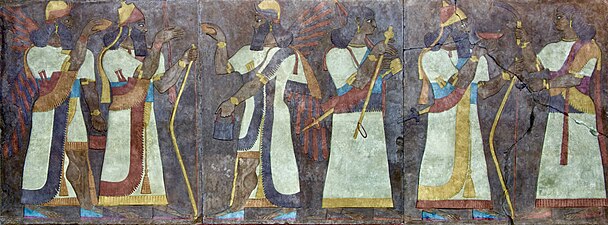
![Fragment of a temple relief, 2150-1991 BC, painted limestone, British Museum, London[8]](http://upload.wikimedia.org/wikipedia/commons/thumb/1/1a/Fragmento_de_relieve_%2831659315857%29.jpg/178px-Fragmento_de_relieve_%2831659315857%29.jpg)


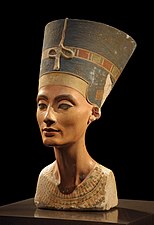


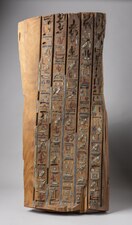




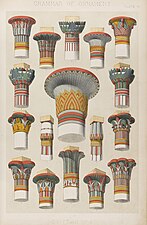





![Carved and painted fragment from the roofline of the Temple of Hera at Paestum, c.520 BC, Museo Archeologico Nazionale, Italy [11]](http://upload.wikimedia.org/wikipedia/commons/thumb/a/a4/Tempio_di_Hera_a_Paestum_%28parte_terminale_del_tetto%29.jpg/522px-Tempio_di_Hera_a_Paestum_%28parte_terminale_del_tetto%29.jpg)

![Hades and Persephone, c.340 BC, pigments on marble, Museum of the Royal Tombs of Aigai, Vergina, Greece[12]](http://upload.wikimedia.org/wikipedia/commons/thumb/f/f8/Hades_and_Persephone%2C_Vergina.jpg/445px-Hades_and_Persephone%2C_Vergina.jpg)


![Tomb of the Palmettes (Mieza, Greece), first half of the third century BC[13]](http://upload.wikimedia.org/wikipedia/commons/thumb/9/95/Anthemion_Makedonian_Tomb_1.jpg/383px-Anthemion_Makedonian_Tomb_1.jpg)
![Terracota figurine of a young woman, with kaolin and traces of polychromy, 3rd-2nd century BC, Liebieghaus, Germany[14]](http://upload.wikimedia.org/wikipedia/commons/thumb/6/69/Frankfurt%2C_Liebieghaus%2C_Figur_einer_jungen_Frau.jpg/148px-Frankfurt%2C_Liebieghaus%2C_Figur_einer_jungen_Frau.jpg)
![Roman mosaic of Neptune and Amphitrite, c.70 BC, mosaic, Casa di Nettuno e Anfitrite, Herculaneum Archaeological Park, Ercolano, Italy[15]](http://upload.wikimedia.org/wikipedia/commons/thumb/e/e4/Neptune_Amphitrite_mosaic_Herculaneum.jpg/376px-Neptune_Amphitrite_mosaic_Herculaneum.jpg)
![Roman shield, mid 3rd century, painted wood and hide, Yale University Art Gallery, New Haven, USA[16]](http://upload.wikimedia.org/wikipedia/commons/thumb/6/64/Ag-obj-5959-001-pub-large.jpg/191px-Ag-obj-5959-001-pub-large.jpg)
![Reconstruction of the Temple of Empedocles at Selinunte, Sicily, by Jacques Ignace Hittorff, 1830 (published in 1851)[17]](http://upload.wikimedia.org/wikipedia/commons/thumb/b/b9/Reconstruction_of_the_Temple_of_Empedocles%2C_Selinunte%2C_Sicily%2C_by_Jacques_Ignace_Hittorff%2C_1830_%28published_in_1851%29.webp/185px-Reconstruction_of_the_Temple_of_Empedocles%2C_Selinunte%2C_Sicily%2C_by_Jacques_Ignace_Hittorff%2C_1830_%28published_in_1851%29.webp.png)




![Guanyin of the southern seas (Chinese), 11th-12th centuries, painted and gilded wood, Nelson-Atkins Museum of Art, Kansas City, USA[19]](http://upload.wikimedia.org/wikipedia/commons/thumb/7/78/Liao_Dynasty_Avalokitesvara_Statue_Clear.jpeg/191px-Liao_Dynasty_Avalokitesvara_Statue_Clear.jpeg)
![Scholar oficial (Chinese), 618-907 AD, painted and glazed ceramic, Shaanxi History Museum, Xi'an, China[20]](http://upload.wikimedia.org/wikipedia/commons/thumb/7/7d/Tang_Pottery_Figure_%2840520339713%29.jpg/170px-Tang_Pottery_Figure_%2840520339713%29.jpg)
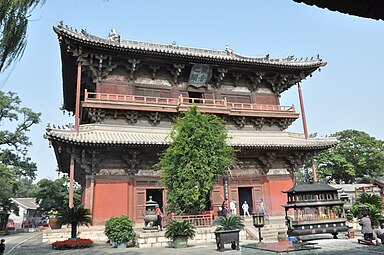

![Figure of a Daoist deity (Chinese), c.1488-1644, porcelain, British Museum, London[21]](http://upload.wikimedia.org/wikipedia/commons/thumb/8/82/Stoneware_figure_of_a_Daoist_deity.From_China%2C_Ming_Dynasty%2C_16th_century_CE._The_British_Museum.jpg/181px-Stoneware_figure_of_a_Daoist_deity.From_China%2C_Ming_Dynasty%2C_16th_century_CE._The_British_Museum.jpg)



![Romanesque - Last Judgement tympanum, Abbey Church of Sainte-Foy, Conques, France, early 12th century[23]](http://upload.wikimedia.org/wikipedia/commons/thumb/0/07/Abbaye_Ste_Foy_%C3%A0_Conques_%2806%29_-_Tympan_du_Porche.jpg/545px-Abbaye_Ste_Foy_%C3%A0_Conques_%2806%29_-_Tympan_du_Porche.jpg)
![Romanesque - Madonna and Child Entroned, 12th century, walnut, silver, silvered copper and polychrome, Basilique Notre-Dame d'Orcival [fr], Orcival, France[24]](http://upload.wikimedia.org/wikipedia/commons/thumb/c/c2/F08.N.-D._d%27Orcival.0489.JPG/170px-F08.N.-D._d%27Orcival.0489.JPG)
![Gothic - Sainte-Chapelle, Paris, by Pierre de Montreuil, 1243-1248[25]](http://upload.wikimedia.org/wikipedia/commons/thumb/3/36/Sainte_Chapelle_Interior_Stained_Glass.jpg/383px-Sainte_Chapelle_Interior_Stained_Glass.jpg)
![Gothic - Ekkehard and Uta, attributed to the Master of Namburg, 1245–1260, limestone and polychromy, Naumburg Cathedral, Naumburg, Germany[26]](http://upload.wikimedia.org/wikipedia/commons/thumb/c/c2/Naumburg_Dom_Stifterfiguren_Uta_und_Ekkehard_2012-04-29-17-31-47.jpg/165px-Naumburg_Dom_Stifterfiguren_Uta_und_Ekkehard_2012-04-29-17-31-47.jpg)
![Gothic - Reliquary altarpiece with Saint Ursula, c.1325, gilded and painted wood, Abteikirche Marienstatt, Streithausen, Germany[27]](http://upload.wikimedia.org/wikipedia/commons/thumb/3/34/Ursula-Altar_in_Marienstatt.jpg/356px-Ursula-Altar_in_Marienstatt.jpg)

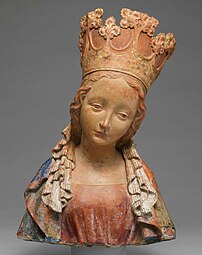

![Gothic - Hôtel-Dieu de Beaune, Beaune, France, by Jacques Wiscrère, 1451[28]](http://upload.wikimedia.org/wikipedia/commons/thumb/e/ef/Beaune_%2821%29_H%C3%B4tel-Dieu_-_Cour_-_01.jpg/170px-Beaune_%2821%29_H%C3%B4tel-Dieu_-_Cour_-_01.jpg)


![Russian portal of the Dormition Cathedral, Moscow, by Aristotele Fioravanti, 1475-1479[29]](http://upload.wikimedia.org/wikipedia/commons/thumb/0/07/Moscow_July_2011-3d.jpg/270px-Moscow_July_2011-3d.jpg)
![Baroque - Escalier des Ambassadeurs of the Palace of Versailles, Versailles, France, by François d'Orbay and Charles Le Brun, 1674-1679, demolished in 1752 under Louis XV[33]](http://upload.wikimedia.org/wikipedia/commons/thumb/d/d5/Chateau_de_Versailles_-_escalier_des_ambassadeurs.jpg/520px-Chateau_de_Versailles_-_escalier_des_ambassadeurs.jpg)
![Baroque - Hall of Mirrors of the Palace of Versailles, by Jules Hardouin-Mansart, 1678-1684[34]](http://upload.wikimedia.org/wikipedia/commons/thumb/f/f1/Chateau_Versailles_Galerie_des_Glaces.jpg/384px-Chateau_Versailles_Galerie_des_Glaces.jpg)


![Rococo - Interior of the Klosterbibliothek Metten [de], Metten, Germany, unknown architect, 1722-1726[35]](http://upload.wikimedia.org/wikipedia/commons/thumb/6/65/Interior_of_the_Klosterbibliothek_Metten%2C_Metten%2C_Germany_%2801%29.jpg/170px-Interior_of_the_Klosterbibliothek_Metten%2C_Metten%2C_Germany_%2801%29.jpg)
![Brâncovenesc - Stavropoleos Monastery Church, Bucharest, Romania, unknown architect, 1724[36]](http://upload.wikimedia.org/wikipedia/commons/thumb/1/1d/4%2C_Strada_Stavropoleos%2C_Bucharest_%28Romania%29_1.jpg/303px-4%2C_Strada_Stavropoleos%2C_Bucharest_%28Romania%29_1.jpg)
![Rococo - Capitals in the Wallfahrtskirche Steinhausen [de], Steinhausen, Germany, by Dominikus Zimmermann, 1728-1733](http://upload.wikimedia.org/wikipedia/commons/thumb/d/df/Steinhausen%2C_Wallfahrtskirche_Unserer_Lieben_Frau%2C_Capital_002.JPG/170px-Steinhausen%2C_Wallfahrtskirche_Unserer_Lieben_Frau%2C_Capital_002.JPG)
![Baroque - Summer as Ceres, part of a series of anthropomorphic busts of the four seasons, a polychrome example of Rouen faience, c.1730, faience, Louvre[37]](http://upload.wikimedia.org/wikipedia/commons/thumb/f/fb/Buste_allegorique_des_4_saisons_-_L%27%C3%A9t%C3%A9_-_Summer_-_Rouen_-_vers_1730_-_Louvre_-_OA_2609.jpg/170px-Buste_allegorique_des_4_saisons_-_L%27%C3%A9t%C3%A9_-_Summer_-_Rouen_-_vers_1730_-_Louvre_-_OA_2609.jpg)

![Rococo - St. Johann Nepomuk, Munich, Germany, by Egid Quirin Asam and Cosmas Damian Asam, 1733-1746[38]](http://upload.wikimedia.org/wikipedia/commons/thumb/5/5c/Asamkirche%2C_M%C3%BAnich%2C_Alemania02.JPG/134px-Asamkirche%2C_M%C3%BAnich%2C_Alemania02.JPG)
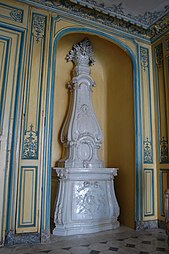
![Rococo - fourth guest room, so-called Voltaire Room, Sanssouci, Potsdam, Germany, designed by Georg Wenzeslaus von Knobelsdorff, with decoration by Johann Michael the Elder and Johann Christian Hoppenhaupt the Younger, 1752-1753[39]](http://upload.wikimedia.org/wikipedia/commons/thumb/d/d4/2022-09-07_09-11_Berlin_217_Potsdam%2C_Schloss_Sanssouci_-_52390814246.jpg/383px-2022-09-07_09-11_Berlin_217_Potsdam%2C_Schloss_Sanssouci_-_52390814246.jpg)
![Rococo - Pilgrimage Church of Wies, Steingaden, Germany, by Dominikus and Johann Baptist Zimmermann, 1754[40]](http://upload.wikimedia.org/wikipedia/commons/thumb/6/64/Wieskirche%2C_Gemeinde_Steingaden_Ortsteil_Wies.JPG/383px-Wieskirche%2C_Gemeinde_Steingaden_Ortsteil_Wies.JPG)
![Rococo - Tobias and the Angel, by Ignaz Günther, 1763, limewood, Bürgersaalkirche, Munich, Germany[41]](http://upload.wikimedia.org/wikipedia/commons/thumb/a/ad/Ignaz_G%C3%BCnther_Schutzengel_B%C3%BCrgersaal.jpg/174px-Ignaz_G%C3%BCnther_Schutzengel_B%C3%BCrgersaal.jpg)
![Chinoiserie - Chinese Pavilion (Ekerö Municipality, Sweden), 1763–1769, by Carl Fredrik Adelcrantz[42]](http://upload.wikimedia.org/wikipedia/commons/thumb/f/f9/Stockholm_Sweden_Royal-Domain-of_Drottningholm_Drottningholms-Kina-Slott-01.jpg/454px-Stockholm_Sweden_Royal-Domain-of_Drottningholm_Drottningholms-Kina-Slott-01.jpg)
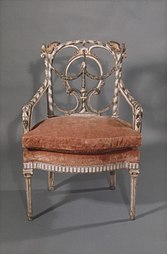
![Louis XVI style - Ceiling decorated with festoons in the State Dining Room, Inveraray Castle, Scotland, the UK, by Girard and Guinand, 1784[43]](http://upload.wikimedia.org/wikipedia/commons/thumb/0/0a/INVERARAY_CASTLE_CEILING_DETAIL.JPG/388px-INVERARAY_CASTLE_CEILING_DETAIL.JPG)


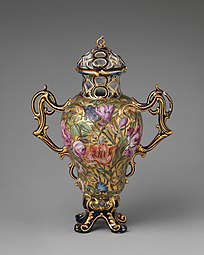


![Louis XVI style - Vase (vase grec Duplessis rectifié), design attributed to Jean-Claude Chambellan Duplessis, painted decoration by Vincent Taillandier [fr], gilding by Jean Pierre Boulanger, by the Sèvres porcelain factory, 1780, painted and gilded hard-paste porcelain, gilt bronze, Rijksmuseum Amsterdam, the Netherlands](http://upload.wikimedia.org/wikipedia/commons/thumb/0/0b/Vase_%28vase_grec_Duplessis_rectifi%C3%A9%29%2C_design_attributed_to_Jean_Claude_Duplessis%2C_Rijksmuseum%2C_Amsterdam%2C_the_Netherlands.jpg/176px-Vase_%28vase_grec_Duplessis_rectifi%C3%A9%29%2C_design_attributed_to_Jean_Claude_Duplessis%2C_Rijksmuseum%2C_Amsterdam%2C_the_Netherlands.jpg)

![Gothic Revival - Interior of the St Giles' Catholic Church, Cheadle, Staffordshire, the UK, by Augustus Pugin, 1840-1846[45]](http://upload.wikimedia.org/wikipedia/commons/thumb/d/de/Cheadle-_St._Giles_Church-_Pugins_complete_c13th_restoration_4_%28geograph_4939277%29.jpg/275px-Cheadle-_St._Giles_Church-_Pugins_complete_c13th_restoration_4_%28geograph_4939277%29.jpg)
![Gothic Revival - Chimney-piece in the Chaucer Room of the Cardiff Castle, Cardiff, the UK, by William Burges, c.1877-1890[46]](http://upload.wikimedia.org/wikipedia/commons/thumb/2/25/Fireplace%2C_the_Chaucer_Room%2C_Cardiff_Castle.jpg/191px-Fireplace%2C_the_Chaucer_Room%2C_Cardiff_Castle.jpg)
![Gothic Revival - Drawing room of the Castell Coch, Tongwynlais, Wales, by William Burges, 1891[47]](http://upload.wikimedia.org/wikipedia/commons/thumb/9/9d/Castell_Coch%2C_April_2022_05.jpg/191px-Castell_Coch%2C_April_2022_05.jpg)
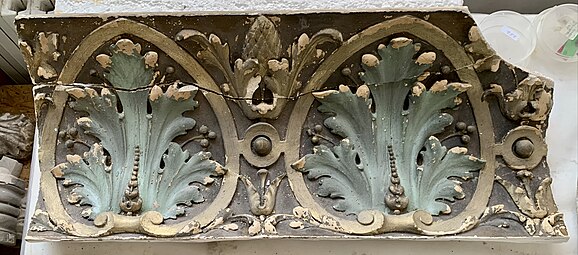


![Empire style - Vase, by the Sèvres porcelain factory, 1814, hard-paste porcelain with platinum background and gilt bronze mounts, Louvre[48]](http://upload.wikimedia.org/wikipedia/commons/thumb/9/96/Pair_of_Spindle_Vases_-_OA_11090_-_Louvre_%2801%29.jpg/140px-Pair_of_Spindle_Vases_-_OA_11090_-_Louvre_%2801%29.jpg)
![Neoclassical - Polychromatic façade of the Cirque Nationale, Paris, by Jakob Ignaz Hittorff, 1840[49]](http://upload.wikimedia.org/wikipedia/commons/thumb/f/ff/Polychromatic_fa%C3%A7ade_of_the_Cirque_Nationale%2C_Paris%2C_by_Jakob_Ignaz_Hittorff%2C_1840.webp/226px-Polychromatic_fa%C3%A7ade_of_the_Cirque_Nationale%2C_Paris%2C_by_Jakob_Ignaz_Hittorff%2C_1840.webp.png)
![Neoclassical - Putto of the Grande Fontaine (Avenue Léopold-Robert), La Chaux-de-Fonds, Switzerland, by Maximilien Louis Bourgeois [fr], 1888](http://upload.wikimedia.org/wikipedia/commons/thumb/f/f2/Fontaine1.jpg/448px-Fontaine1.jpg)


![Rococo Revival incense burner (brûle-parfum), by Jacob Petit [fr], c.1834-1848, hard-paste porcelain, painted and gilded, Museum of Decorative Arts, Paris](http://upload.wikimedia.org/wikipedia/commons/thumb/d/dc/Incense_burner_%28br%C3%BBle-parfum%29%2C_by_Jacob_Petit%2C_circa_1834-1848%2C_hard-paste_porcelain%2C_painted_and_gilded%2C_given_by_Madame_Albert_King%2C_1948%2C_inv._35970%2C_Museum_of_Decorative_Arts%2C_Paris.jpg/201px-thumbnail.jpg)


![Neoclassical sculpted decoration on the ceiling of the Salon des Sept cheminées, Louvre Palace, Paris, by Francisque Duret, 1851[52]](http://upload.wikimedia.org/wikipedia/commons/thumb/3/35/Ceiling_of_the_Salle_des_Sept-Chemin%C3%A9es_in_the_Louvre_Palace_%2828223543502%29.jpg/383px-Ceiling_of_the_Salle_des_Sept-Chemin%C3%A9es_in_the_Louvre_Palace_%2828223543502%29.jpg)
![Neoclassical sculpted decoration on the ceiling of the Salon Carré, Louvre Palace, by Pierre-Charles Simart, 1851[53]](http://upload.wikimedia.org/wikipedia/commons/thumb/1/12/Salon_Carr%C3%A9_Ceiling.jpg/423px-Salon_Carr%C3%A9_Ceiling.jpg)

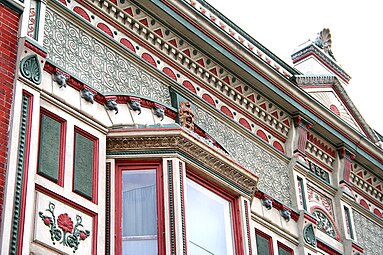

![Interior of All Saints, Margaret Street, London, 1850–1859, by William Butterfield[55]](http://upload.wikimedia.org/wikipedia/commons/thumb/4/44/All_Saints_Margaret_Street_Interior_2%2C_London%2C_UK_-_Diliff.jpg/326px-All_Saints_Margaret_Street_Interior_2%2C_London%2C_UK_-_Diliff.jpg)
![Ampton Road no. 12, Edgbaston, Birmingham, the UK, by John Henry Chamberlain, 1855[56]](http://upload.wikimedia.org/wikipedia/commons/thumb/6/6c/Shenstone-House%2C-Edgbaston%2C-Birmingham---John-Henry-Chamberlain.jpg/272px-Shenstone-House%2C-Edgbaston%2C-Birmingham---John-Henry-Chamberlain.jpg)

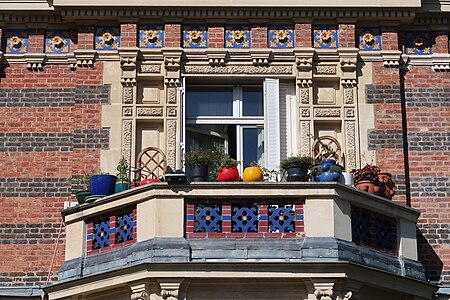
![Avenue des Minimes no. 58, Vincennes, France, by Victor Francione, 1905[57]](http://upload.wikimedia.org/wikipedia/commons/thumb/7/7d/Maison_58_avenue_Minimes_Vincennes_2.jpg/400px-Maison_58_avenue_Minimes_Vincennes_2.jpg)
![Gheorghe Ionescu-Gion House (Strada Logofătul Udriște no. 11), Bucharest, Romania, by Ion N. Socolescu, 1889[59]](http://upload.wikimedia.org/wikipedia/commons/thumb/0/0a/11_Strada_Logof%C4%83tul_Udri%C8%99te%2C_Bucharest_%2805%29.jpg/308px-11_Strada_Logof%C4%83tul_Udri%C8%99te%2C_Bucharest_%2805%29.jpg)
![Central Girls' School, Bucharest, by Ion Mincu, 1890[60]](http://upload.wikimedia.org/wikipedia/commons/thumb/f/f8/3-5_Strada_Icoanei%2C_Bucharest_%2848%29.jpg/328px-3-5_Strada_Icoanei%2C_Bucharest_%2848%29.jpg)
![Ceiling of the Gheorghe Petrașcu House (Piața Romană no. 5), Bucharest, by Spiru Cegăneanu, 1912[61]](http://upload.wikimedia.org/wikipedia/commons/thumb/c/c4/5_Pia%C8%9Ba_Roman%C4%83%2C_Bucharest_%2804%29.jpg/179px-5_Pia%C8%9Ba_Roman%C4%83%2C_Bucharest_%2804%29.jpg)
![Ceiling of the Gheorghe Petrașcu House, Bucharest, by Spiru Cegăneanu, 1912[62]](http://upload.wikimedia.org/wikipedia/commons/thumb/2/2b/5_Pia%C8%9Ba_Roman%C4%83%2C_Bucharest_%2819%29.jpg/328px-5_Pia%C8%9Ba_Roman%C4%83%2C_Bucharest_%2819%29.jpg)
![Rococo Revival - Boulangerie (Boulevard Beaumarchais no. 28), Paris, 1900, by Benoit et fils[63]](http://upload.wikimedia.org/wikipedia/commons/thumb/2/2e/Bakery%2C_Rue_du_Pasteur-Wagner%2C_Paris%2C_2016.jpg/406px-Bakery%2C_Rue_du_Pasteur-Wagner%2C_Paris%2C_2016.jpg)
![French Art Nouveau - Bijouterie Fouquet, Musée Carnavalet, Paris, by Alphonse Mucha, c. 1900[64]](http://upload.wikimedia.org/wikipedia/commons/thumb/8/85/Alphonse_mucha%2C_boutique_fouquet%2C_1899%2C_02.JPG/180px-Alphonse_mucha%2C_boutique_fouquet%2C_1899%2C_02.JPG)
![French Art Nouveau - Vase, by Clément Massier, c.1900, lusterware, Jason Jacques Gallery, New York[65]](http://upload.wikimedia.org/wikipedia/commons/thumb/e/ed/Clement_massier.jpg/177px-Clement_massier.jpg)

![French Art Nouveau - Rue Jean-Bellegambe no. 21, Douai, France, by Pepe Albert, 1904[66]](http://upload.wikimedia.org/wikipedia/commons/thumb/8/82/Douai_Rue_Pollinchove_-Fa%C3%A7ade_tournesol_-1902_-_Andr%C3%A9_P%C3%A9pe_Architecte.jpg/202px-Douai_Rue_Pollinchove_-Fa%C3%A7ade_tournesol_-1902_-_Andr%C3%A9_P%C3%A9pe_Architecte.jpg)
![French Art Nouveau - Entrance decorated with glazed tiles of the Les Chardons Building (Rue Eugène-Manuel no. 2), Paris, 1903, by Charles Klein[67]](http://upload.wikimedia.org/wikipedia/commons/thumb/5/56/Entr%C3%A9e_dun_immeuble_art_nouveau_%28Paris%29_%284807519051%29.jpg/213px-Entr%C3%A9e_dun_immeuble_art_nouveau_%28Paris%29_%284807519051%29.jpg)
![Ukrainian Art Nouveau - Poltava Reginal Administrative Building, Poltava, Ukraine, by Vasyl Krychevsky, 1903–1907[68]](http://upload.wikimedia.org/wikipedia/commons/thumb/d/d6/%D0%91%D1%83%D0%B4%D0%B8%D0%BD%D0%BE%D0%BA_%D0%B7%D0%B5%D0%BC%D1%81%D1%82%D0%B2%D0%B0_P1230868_%D0%BF%D0%BB._%D0%9A%D0%BE%D0%BD%D1%81%D1%82%D0%B8%D1%82%D1%83%D1%86%D1%96%D1%97%2C_2.jpg/404px-%D0%91%D1%83%D0%B4%D0%B8%D0%BD%D0%BE%D0%BA_%D0%B7%D0%B5%D0%BC%D1%81%D1%82%D0%B2%D0%B0_P1230868_%D0%BF%D0%BB._%D0%9A%D0%BE%D0%BD%D1%81%D1%82%D0%B8%D1%82%D1%83%D1%86%D1%96%D1%97%2C_2.jpg)
![Austrian Art Nouveau - Putto with two cornucopias with floral cascades, by Michael Powolny, designed in c.1907, produced in 1912, ceramic, Kunstgewerbemuseum Berlin, Berlin, Germany[69]](http://upload.wikimedia.org/wikipedia/commons/thumb/0/08/Michael_powolny_e_bertold_l%C3%B6ffler%2C_putto_con_cornucopia%2C_vienna_1912_ca.jpg/221px-Michael_powolny_e_bertold_l%C3%B6ffler%2C_putto_con_cornucopia%2C_vienna_1912_ca.jpg)

![Moorish Revival - Ceiling in the Filitti House (Calea Dorobanților [ro] no. 18), Bucharest, by Ernest Doneaus, c.1910[70]](http://upload.wikimedia.org/wikipedia/commons/thumb/9/93/18_Calea_Doroban%C8%9Bilor%2C_Bucharest_%2804%29.jpg/370px-18_Calea_Doroban%C8%9Bilor%2C_Bucharest_%2804%29.jpg)


![De Stijl - Panel of polychrome bricks on the exterior of the Vakantiehuis De Vonk [nl], a house in Noordwijkerhout, the Netherlands, by Theo van Doesburg, 1917-1919[73]](http://upload.wikimedia.org/wikipedia/commons/thumb/5/51/Theo_van_Doesburg_brick_mosaic.jpg/444px-Theo_van_Doesburg_brick_mosaic.jpg)



![Art Deco - Marble facing in the entrance hall of Strada Pitar Moș no. 27–29, Bucharest, by Sandy Herivan, 1931-1933[75]](http://upload.wikimedia.org/wikipedia/commons/thumb/f/fc/27_Strada_Pitar_Mo%C8%99%2C_Bucharest_%2804%29.jpg/174px-27_Strada_Pitar_Mo%C8%99%2C_Bucharest_%2804%29.jpg)
![Art Deco - Mosaics on the facade of Quai Louis-Blériot no. 40, Paris, by Marteroy & Bonnel, 1932[76]](http://upload.wikimedia.org/wikipedia/commons/thumb/8/8c/Immeuble_Art_D%C3%A9co%2C_quai_Louis_Bl%C3%A9riot_%2844446833331%29.jpg/383px-Immeuble_Art_D%C3%A9co%2C_quai_Louis_Bl%C3%A9riot_%2844446833331%29.jpg)
![International Style - Unité d'habitation, Marseilles, France, by Le Corbusier, 1952[77]](http://upload.wikimedia.org/wikipedia/en/thumb/7/70/Unit%C3%A9_d%27habitation_de_Firminy.jpg/170px-Unit%C3%A9_d%27habitation_de_Firminy.jpg)
![Mid-century modern - Marshmallow sofa, by Irving Harper for George Nelson Associates, 1956, metal frame with round discs of covered foam, unknown location[78]](http://upload.wikimedia.org/wikipedia/commons/thumb/d/db/Circular.jpg/340px-Circular.jpg)
![Fusterlandia, Havana, Cuba, by José Rodríguez Fuster, 1975[79]](http://upload.wikimedia.org/wikipedia/commons/thumb/8/84/Fusterlandia_2019_november.jpg/206px-Fusterlandia_2019_november.jpg)
![Dona i Ocell, by Joan Miró, 1983, glazed tile mosaic, Barcelona, Spain[80]](http://upload.wikimedia.org/wikipedia/commons/thumb/9/9b/Joan_Miro_-_Dona_i_ocell_%281%29.jpg/170px-Joan_Miro_-_Dona_i_ocell_%281%29.jpg)
![Proust armchair, by Studio Alchimia, 1978, wood and fabric, Indianapolis Museum of Art, Indianapolis, USA[83]](http://upload.wikimedia.org/wikipedia/commons/thumb/8/8a/Alessandro_mendini_per_atelier_mendini_e_studio_alchimia%2C_poltrona_di_proust%2C_1978.jpg/263px-Alessandro_mendini_per_atelier_mendini_e_studio_alchimia%2C_poltrona_di_proust%2C_1978.jpg)
![Sheraton chair with applied decoration, by Robert Venturi for Knoll, 1978-1984, bent laminated wood, Milwaukee Art Museum, Milwaukee, USA[84]](http://upload.wikimedia.org/wikipedia/commons/thumb/b/be/Robert_venturi_e_denise_scott_brown_per_knoll_international_inc.%2C_sedia_sheraton_%28mod._664%29%2C_1979-83_%281984-90%29.jpg/176px-Robert_venturi_e_denise_scott_brown_per_knoll_international_inc.%2C_sedia_sheraton_%28mod._664%29%2C_1979-83_%281984-90%29.jpg)

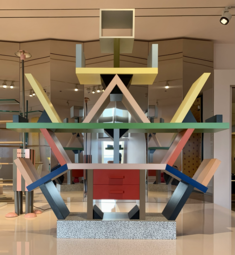

![Neue Staatsgalerie, Stuttgart, Germany, by James Stirling, 1984[85]](http://upload.wikimedia.org/wikipedia/commons/thumb/b/bb/Stuttgart_-_Neue_Staatsgalerie_%2835736927202%29.jpg/383px-Stuttgart_-_Neue_Staatsgalerie_%2835736927202%29.jpg)
![Louis XVI, lowboy, by Robert Venturi for Arc International, c.1985, laminated wood, Indianapolis Museum of Art[86]](http://upload.wikimedia.org/wikipedia/commons/thumb/5/50/Robert_venturi_per_paul_downs_cabinetmakers%2C_comodino_louis_xvi%2C_1984.jpg/278px-Robert_venturi_per_paul_downs_cabinetmakers%2C_comodino_louis_xvi%2C_1984.jpg)
![Isle of Dogs Pumping Station, London, John Outram, 1988[87]](http://upload.wikimedia.org/wikipedia/commons/thumb/0/09/Pumping_station%2C_Stewart_Street_%28geograph_4678320%29.jpg/228px-Pumping_station%2C_Stewart_Street_%28geograph_4678320%29.jpg)
![No 1 Poultry, London, by James Stirling, designed in 1988 but built in 1997[88]](http://upload.wikimedia.org/wikipedia/commons/thumb/2/21/No_1_Poultry_%281398376326%29_%28cropped%29.jpg/204px-No_1_Poultry_%281398376326%29_%28cropped%29.jpg)
![Oudhof (Rokin no. 99), Amsterdam, Netherlands, by Mart van Schijndel [nl], 1988-1990[89]](http://upload.wikimedia.org/wikipedia/commons/thumb/3/3b/De_Wallen%2C_Amsterdam%2C_Netherlands_-_panoramio_%2847%29.jpg/170px-De_Wallen%2C_Amsterdam%2C_Netherlands_-_panoramio_%2847%29.jpg)
![Main hall of the Judge Business School, University of Cambridge, England, by John Outram, 1995[90]](http://upload.wikimedia.org/wikipedia/commons/thumb/8/81/Cambridge_University_Judge_Business_School_interior.jpg/191px-Cambridge_University_Judge_Business_School_interior.jpg)
![Duncan Hall, Rice University, US, by John Outram, 1996[91]](http://upload.wikimedia.org/wikipedia/commons/thumb/2/21/Duncan_Hall_at_Rice_University.jpg/383px-Duncan_Hall_at_Rice_University.jpg)


![Roof of the Santa Caterina Market, Barcelona, Spain, by Benedetta Tagliabue and Enric Miralles, 2004[96]](http://upload.wikimedia.org/wikipedia/commons/thumb/a/a2/Mercat_%287630136962%29.jpg/384px-Mercat_%287630136962%29.jpg)
![Buildings in El Alto, Bolivia, by Freddy Mamani (architect), after 2005[97]](http://upload.wikimedia.org/wikipedia/commons/thumb/6/6b/Cholet1.jpg/292px-Cholet1.jpg)
![House for Essex, Wrabness, Essex, the UK, by FAT and Grayson Perry, 2014[98]](http://upload.wikimedia.org/wikipedia/commons/thumb/6/65/A_House_For_Essex_-_geograph.org.uk_-_4471511.jpg/340px-A_House_For_Essex_-_geograph.org.uk_-_4471511.jpg)
![Xiafu Activity Center, Xiafu, Taiwan, by IMO Architecture + Design and JC Cheng & Associates, Architects & Planners, 2017[99]](http://upload.wikimedia.org/wikipedia/commons/thumb/0/0e/IMOXiafuActivityCenter01.jpg/191px-IMOXiafuActivityCenter01.jpg)

![Miami Museum Garage, Miami, USA, by WORKac, 2018[100]](http://upload.wikimedia.org/wikipedia/commons/thumb/c/c8/Museum_Garage_Design_District.jpg/282px-Museum_Garage_Design_District.jpg)
![The Colour Palace, Dulwich Picture Gallery, London, by Pricegore and Yinka Ilori, 2019[101]](http://upload.wikimedia.org/wikipedia/commons/thumb/2/23/Dulwich_Village._Dulwich_Pavilion_2019._The_Colour_Palace.jpg/226px-Dulwich_Village._Dulwich_Pavilion_2019._The_Colour_Palace.jpg)
![Biomuseo, Panama City, Panama, by Frank Gehry, partially opened in 2014, completed in 2019[102]](http://upload.wikimedia.org/wikipedia/commons/thumb/d/d6/Biomuseo_rear_stereo_pair_R.agr_%28cropped%29.jpg/392px-Biomuseo_rear_stereo_pair_R.agr_%28cropped%29.jpg)
![Presence in Hormoz 02, Hormoz Island, Hormozgan, Iran, by ZAV Architects, 2020[103]](http://upload.wikimedia.org/wikipedia/commons/thumb/8/80/Tahmineh_Monzavi_Photo_Majara_Residence_Hormuz_Iran_View_from_the_sea_2020.jpg/383px-Tahmineh_Monzavi_Photo_Majara_Residence_Hormuz_Iran_View_from_the_sea_2020.jpg)
